
List of Korean clothing
Encyclopedia
Hanbok is a traditional clothing of korea.
This is a list of Korea
n clothing including the national costume, hanbok
as well as headgear
, footwear
, and accessories.
Hanbok
This is a list of Korea
Korea
Korea ) is an East Asian geographic region that is currently divided into two separate sovereign states — North Korea and South Korea. Located on the Korean Peninsula, Korea is bordered by the People's Republic of China to the northwest, Russia to the northeast, and is separated from Japan to the...
n clothing including the national costume, hanbok
Hanbok
Hanbok or Chosŏn-ot is the traditional Korean dress. It is often characterized by vibrant colors and simple lines without pockets. Although the term literally means "Korean clothing", hanbok today often refers specifically to hanbok of Joseon Dynasty and is worn as semi-formal or formal wear...
as well as headgear
Headgear
Headgear, headwear or headdress is the name given to any element of clothing which is worn on one's head.Headgear serve a variety of purposes:...
, footwear
Footwear
Footwear consists of garments worn on the feet, for fashion, protection against the environment, and adornment. Being barefoot is commonly associated with poverty, but some cultures chose not to wear footwear at least in some situations....
, and accessories.
HanbokHanbokHanbok or Chosŏn-ot is the traditional Korean dress. It is often characterized by vibrant colors and simple lines without pockets. Although the term literally means "Korean clothing", hanbok today often refers specifically to hanbok of Joseon Dynasty and is worn as semi-formal or formal wear...
| Baji Baji (clothing) Baji is a kind of traditional Korean pant that is part of the hanbok. A baji is baggy and loose, so it is tied around the waist. In the past, Korean men wore baji as outer clothing, but for women, it gradually became part of the inner clothing. Today, women wear chima for their outer clothes.... |
baggy pants (see more pictures at commons:Category:Baji) | |
| Chima Chima (clothing) Chima is a type of skirt worn together with jeogori, or a short jacket in hanbok, Korean traditional clothing. It is also referred to as sang or gun in hanja, Chinese characters adapted for Korean language.... |
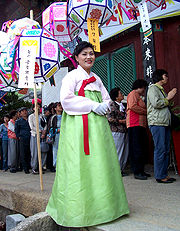 |
Chima is a type of skirt worn together with jeogori Jeogori The jeogori is a basic upper garment of hanbok, Korean traditional garment, which has been worn by both men and women. It covers the arms and upper part of the wearer's body.-Etymology:... , short jacket. |
| Dangui Dangui Dang'ui is a type of upper garment for women in hanbok, Korean traditional clothing, which was worn for ceremonial occasions during the Joseon Dynasty. It was worn as a simple official outfit or for small national ceremonies while court ladies wore it as a daily garment... |
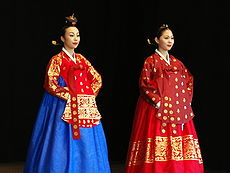 |
Dangui is a female upper garment worn for ceremonial occasions during the Joseon Dynasty Joseon Dynasty Joseon , was a Korean state founded by Taejo Yi Seong-gye that lasted for approximately five centuries. It was founded in the aftermath of the overthrow of the Goryeo at what is today the city of Kaesong. Early on, Korea was retitled and the capital was relocated to modern-day Seoul... . Dangui was also called dang-jeogori Jeogori The jeogori is a basic upper garment of hanbok, Korean traditional garment, which has been worn by both men and women. It covers the arms and upper part of the wearer's body.-Etymology:... (당저고리), dang-jeoksam (당적삼), or dang-hansam (당한삼). |
| Dopo Dopo (clothing) The dopo is a variety of po, or overcoat in hanbok, Korean traditional garment which was mostly worn by male Confucian scholars called seonbi after the mid Joseon period. Seonbi wore it as their daily garment as well as government officers did when they out for their private business. There are... |
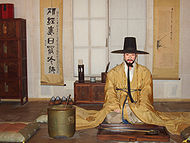 |
Dopo is a variety of po Po (clothing) The po is a generic term referring to an outer robe or overcoat in hanbok, Korean traditional clothing, which was worn mostly by men since the Goryeo period until the Joseon period.-See also:*Jeogori*Dopo*Durumagi*Sagyusam*Jeonbok*Hanbok... (an overcoat) mostly worn by male Confucian scholars called seonbi Seonbi Seonbi means "virtuous scholar" in Korean and typically denotes young nobleman who was preparing for the gwageo examination or passed it but did not take on government position during Joseon Dynasty... since the mid Joseon period. |
| Durumagi Durumagi Durumagi is a variety of po, or overcoat in hanbok, the Korean traditional garment. It is usually the topmost layer of clothing that is worn over jeogori and baji . Durumagi means "closed all around", and is also known as jumagui , juchaui or juui... |
||
| Garot Garot Garot or galjungi is a variety of hanbok, Korean traditional clothing, which has been worn by locals of Jeju Island in Korea as a working clothes and everyday dress. Although there is no historical record on its origin, it is known that Jeju farmers and fishermen have worn it for a long time... |
Garot is a type of working and everyday dress dyed with juice of unripe persimmon Persimmon A persimmon is the edible fruit of a number of species of trees in the genus Diospyros in the ebony wood family . The word Diospyros means "the fire of Zeus" in ancient Greek. As a tree, it is a perennial plant... s. It has been worn by Jeju Island locals. |
|
| Hakchangui | ||
| Hwarot Hwarot Hwarot is a type of traditional Korean clothing worn during the Goryeo and Joseon Dynasty by royal women for ceremonial occasions or by commoners for weddings. It originated from the Kingdom of Khotan, Central Asia.... |
 |
|
| Jeogori Jeogori The jeogori is a basic upper garment of hanbok, Korean traditional garment, which has been worn by both men and women. It covers the arms and upper part of the wearer's body.-Etymology:... |
Jeogori is a basic upper garment which has been worn by both men and women. It covers arms and upper part of the wearer's body. | |
| Jeonbok Jeonbok The jeonbok is a type of sleeveless long vest in hanbok, traditional Korean clothing, which was worn by military personnel. It does not have overlapped column on the front side, and was worn over dongdari .... |
Jeonbok is a type of sleeveless long vest mostly worn by military personnel. It does not have overlapped column on the front side, and was worn over dongdari. | |
| Jokki | vest | |
| Kkachi durumagi Kkachi durumagi Kkachi durumagi is a children's colorful overcoat in hanbok, traditional Korean clothing, which was worn on Seolnal, New Year's Day in the Lunar calendar. It was worn mostly by young boys and literally means "a magpie's overcoat". The clothes is also called obangjang durumagi which denotes "an... |
Kkachi durumagi is a children's colorful overcoat worn on Korean New Year Korean New Year Korean New Year, commonly known as Seollal , is the first day of the lunar calendar. It is the most important of the traditional Korean holidays. It consists of a period of celebrations, starting on New Year's Day. Koreans also celebrate solar New Year's Day on January 1 each year, following the... . It was worn over a jeogori Jeogori The jeogori is a basic upper garment of hanbok, Korean traditional garment, which has been worn by both men and women. It covers the arms and upper part of the wearer's body.-Etymology:... or jokki while the wearer could put a jeonbok Jeonbok The jeonbok is a type of sleeveless long vest in hanbok, traditional Korean clothing, which was worn by military personnel. It does not have overlapped column on the front side, and was worn over dongdari .... over it. Kkachi durumagi was also worn along with headgear such as bokgeon Bokgeon Bokgeon is a type of gwanmo , traditional Korean headgear made from a black fabric. Although it had been worn by a few Confucian scholars until the late Joseon period, it later became a decorative headgear for baby boys' dol which is a way of celebrating the birthday of a one-year-old baby.... , hogeon Hogeon A hogeon is a type of gwanmo , Korean traditional headgear for young boys aged one year to five years old. It was worn along with durumagi or jeonbok . Hogeon was worn on holidays such as Seolnal , Chuseok , or celebrations for their birthdays like doljanchi... or gulle Gulle A gulle is a type of sseugae , Korean traditional headgear, worn by children aged one year to five years old during the late Joseon period. It was mostly worn by young girls in the upper class for warmth and style. Gullae was usually made with silk and in summer, it was made with sa , a type of... . |
|
| Magoja Magoja Magoja is a type of upper garment in hanbok, traditional Korean costume which is worn over jeogori . It is also called magwae and was originally a male garment, but later became a unisex clothing... |
||
| Po Po (clothing) The po is a generic term referring to an outer robe or overcoat in hanbok, Korean traditional clothing, which was worn mostly by men since the Goryeo period until the Joseon period.-See also:*Jeogori*Dopo*Durumagi*Sagyusam*Jeonbok*Hanbok... |
||
| Sagyusam Sagyusam The sagyusam is a type of po , or outer robe in hanbok, Korean traditional clothing, which was worn by young boys until they had a coming-of-age ceremony called gwallye . The name was derived from the shape; the lower end of the garment is divided into four parts.... |
Sagyusam is a type of po Po (clothing) The po is a generic term referring to an outer robe or overcoat in hanbok, Korean traditional clothing, which was worn mostly by men since the Goryeo period until the Joseon period.-See also:*Jeogori*Dopo*Durumagi*Sagyusam*Jeonbok*Hanbok... (outer robe) worn by young boys until they had a coming-of-age ceremony called gwallye. The name was derived from the shape; the lower end of the garment is divided into four parts. |
|
| Saekdongot Saekdongot The saekdongot is a type of hanbok, Korean traditional clothing, with colorful stripes by patchworking. It began to be used for hanbok since the Goryeo period . The name literally means "many colored clothes " in Korean. It was usually worn by children from the age of one to seven year old... |
Saekdongot is any hanbok patchwork Patchwork Patchwork or "pieced work" is a form of needlework that involves sewing together pieces of fabric into a larger design. The larger design is usually based on repeat patterns built up with different colored shapes. These shapes are carefully measured and cut, straight-sided, basic geometric shapes... ed with colorful stripes. It began to be made since the Goryeo period (918 – 1392). The name literally means "many colored clothing". It was usually worn by children of the age at one to seven year old. The saekdong can be applied throughout jeogori Jeogori The jeogori is a basic upper garment of hanbok, Korean traditional garment, which has been worn by both men and women. It covers the arms and upper part of the wearer's body.-Etymology:... (short jacket with sash), majoja (buttoned jacket), durumagi Durumagi Durumagi is a variety of po, or overcoat in hanbok, the Korean traditional garment. It is usually the topmost layer of clothing that is worn over jeogori and baji . Durumagi means "closed all around", and is also known as jumagui , juchaui or juui... (overcoat) or among others. |
|
| Wonsam Wonsam The wonsam is a female ceremonial topcoat in hanbok, Korean traditional clothing. It was worn by queens, high-ranking court ladies, and royalty during the Joseon Dynasty of Korea . It is also called daeui , daesu and jangsam... |
 |
Wonsam is a female ceremonial topcoat Topcoat Topcoat may refer to:*A lightweight overcoat*The guard hairs of an animal's fur*A transparent or translucent coat of paint applied over the underlying material as a sealer... during the Joseon Dynasty Joseon Dynasty Joseon , was a Korean state founded by Taejo Yi Seong-gye that lasted for approximately five centuries. It was founded in the aftermath of the overthrow of the Goryeo at what is today the city of Kaesong. Early on, Korea was retitled and the capital was relocated to modern-day Seoul... . The queen, princess consort, and consort to the first son of the crown prince wore it as a soryebok, a robe for small ceremonies, while wives of high officers and sanggung (court matrons) wore it as daeryebok, a robe for major ceremonies. The color and decorations of the garment around the chest, shoulders and back represent the wearer's rank. |
Headgear
| Ayam Ayam (cap) An ayam is a Korean traditional winter cap mostly worn by women in the Joseon period for protection against the cold. It is also called aegeom which literally means "covering a forehead" in Korean. There is a historical record which mentions that officials in a low class called iseo wore ayam in... |
An ayam is a traditional winter cap Cap A cap is a form of headgear. Caps have crowns that fit very close to the head and have no brim or only a visor. They are typically designed for warmth and, when including a visor, blocking sunlight from the eyes... mostly worn by women during the Joseon period. It is also called aegeom meaning "covering a forehead". The ayam consists of a crown and trailing big ribbons. The upper part of the crown is finely quilt Quilt A quilt is a type of bed cover, traditionally composed of three layers of fiber: a woven cloth top, a layer of batting or wadding and a woven back, combined using the technique of quilting. “Quilting” refers to the technique of joining at least two fabric layers by stitches or ties... ed, and its outer fabric consists of black or purple silk Silk Silk is a natural protein fiber, some forms of which can be woven into textiles. The best-known type of silk is obtained from the cocoons of the larvae of the mulberry silkworm Bombyx mori reared in captivity... . While black or dark brown fur is used for the rest of the crown. The fabric for the inner is red cotton flannel. A tassel attached to the upper center of both front and back. Some ayam worn by kisaeng Kisaeng Kisaeng , sometimes called ginyeo , were female Korean official prostitute or entertainers. Kisaeng are artists who work to entertain others, such as the yangbans and kings.... (female entertainer) were luxuriously adorned with jewels. The ayam worn for spring and autumn has the same shape as the one for winter, but it is made of a lighter silk. |
|
| Banggeon | ||
| Beonggeoji Beonggeoji A beonggeoji is a Korean hat worn by military officers in a low class or servants of yangban, aristocrats during the Joseon Dynasty. It is also called jeonnip or byeongnip. It began to be worn in the northwestern region of Korea and was spread to nationwide after Imjin Waeran and Second Manchu... |
||
| Bokgeon Bokgeon Bokgeon is a type of gwanmo , traditional Korean headgear made from a black fabric. Although it had been worn by a few Confucian scholars until the late Joseon period, it later became a decorative headgear for baby boys' dol which is a way of celebrating the birthday of a one-year-old baby.... |
||
| Chaek | ||
| Daesu | ||
| Gache Gache Gache is a big wig worn by Korean women. Women of high social backgrounds and gisaeng wore wigs . Like their western contemporaries Koreans considered bigger and heavier wigs to be more aesthetic... |
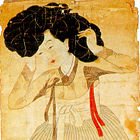 |
wig |
| Gat | ||
| Gulle Gulle A gulle is a type of sseugae , Korean traditional headgear, worn by children aged one year to five years old during the late Joseon period. It was mostly worn by young girls in the upper class for warmth and style. Gullae was usually made with silk and in summer, it was made with sa , a type of... |
||
| Hogeon Hogeon A hogeon is a type of gwanmo , Korean traditional headgear for young boys aged one year to five years old. It was worn along with durumagi or jeonbok . Hogeon was worn on holidays such as Seolnal , Chuseok , or celebrations for their birthdays like doljanchi... |
||
| Hwagwan Hwagwan Hwagwan is a type of Korean coronet worn by women, traditionally for ceremonial occasions such as weddings. It is similar to thejokduri in shape and function, but the hwagan is more elaborate.... |
Hwagwan is a type of Korean coronet worn by women traditionally for ceremonial occasions such as wedding. | |
| Ikseongwan | 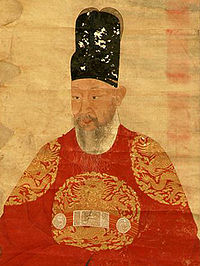 |
|
| Jangot Jangot A Jangot is a type of clothing worn by women of the Joseon Dynasty period as a veil to cover their faces. Jangot is similar to durumagi, or the outer jacket of a hanbok. The difference is, a jangot has a collar and a ribbon for tying... |
||
| Jeongjagwan Jeongjagwan Jeongjagwan is a type of gwanmo , a traditional Korean hat, worn by men from the yangban, the upper class of the Joseon period. It was mostly worn at home as a daily headgear instead of a gat, a formal headgear. Jeongjagwan is made with horse hair... |
 |
|
| Jeonmo | ||
| Jobawi Jobawi A jobawi is a type of traditional Korean winter cap with earflaps which was worn by women and was made of silk. Since its first appearance in the late Joseon period, it has been widely worn as a substitute for the ayam... |
||
| Jokduri Jokduri A jokduri is a type of Korean traditional coronet worn by women for special occasions such as weddings. It consists of an outer crown which is covered with black silk, and the inner which is filled with cotton and hard paper. Its top is decorated with cloisonné ornaments. The crown is also called... |
||
| Joujeolpung | ||
| Manggeon Manggeon Manggeon is a kind of traditional Korean headband worn by men to hold their hair in place in the sangtu . It is usually made of dyed horsehair. Artisans who specialize in making manggeon are called manggeonjang .... |
||
| Nambawi Nambawi A nambawi is a type of traditional Korean winter hat worn by both men and women during the Joseon period for protection against the cold. The other names for it are pungdengi and nani . The nambawi is also called ieom which was worn in the early Joseon period, although it was derived from the cap... |
||
| Pungcha Pungcha A pungcha is a type of traditional Korean winter hat worn by both men and women during the Joseon period for protection against the cold. It is also called pungchae and jeongpungcha. Although its shape is very similar with nambawi, the pungcha has a bolkki attached on both sides of the ears... |
||
| Tanggeon Tanggeon Tanggeon is a type of Korean traditional headgear worn by men, which is put under a gat . It is usually made of dyed horsehair or cow hair. Artisans who specialize in making tanggeon are called tanggeonjang.... |
||
| Tongcheongwan | ||
| Satgat |  |
|
| Sseugae chima | ||
| Waryonggwan | ||
| Yanggwan Yanggwan A yanggwan is a ceremonial hat worn by Korean officials during events such as a wedding ceremony, prayer ceremony like that practiced on Chuseok, and other ceremonies. It is considered a crown. It is usually worn with a jobok which is worn by Korean officials. -See also:*List of Korean... |
Yanggwan was a kind of crown worn by officials when they wore a jobok (朝服) and jebok (祭服, ceremonial clothing) during the Joseon Dynasty.http://hair.culturecontent.com/dress/kwan_man_09.asp |
Footwear
| Beoseon Beoseon The beoseon is a type of paired socks worn with hanbok, Korean traditional clothing and is made of fabrics for protection, warmth, and style of ones foot. It is also called jokui , jokgeon or mal in hanja... |
||
| Gomusin Gomusin Gomusin refers to shoes made of rubber in a form of Korean traditional shoes. The shoes are wide, with low heels. Gomusin for men were modeled after "gatsin" , and ones for women were danghye . Gomusin first appeared in the early 20th century. They were much easier to keep clean than danghye and... |
literally "rubber shoes". In present it is mostly worn by elder people and Buddhist monks and nunshttp://100.nate.com/dicsearch/pentry.html?s=K&i=236485&v=42 | |
| Hwa Hwa Hwa are a type of traditional Korean boot, which, along with yi , is a subdivision of Korean shoes. The yi refers to all kind of shoes that do not go up to ankle. Hwa are usually made of leather, and artisans who make the shoes are called hwajang . It was originally worn by ethnic minorities of... |
generic term referring to all kinds of boots | |
| Hye (혜) | Varieties: Buntuhye (분투혜), taesahye (태사혜), danghye (당혜), unhye (운혜)http://100.nate.com/dicsearch/pentry.html?s=K&i=258304&v=43 | |
| Jipsin Jipsin Jipsin are Korean traditional sandals made of straw. Koreans have worn straw sandals since ancient times. They are categorized as yi , shoes with a short height, and the specific name can vary according to the ingredients, as with samsin, wanggolsin, cheongol jisin, and budeulsin. In the Joseon... |
||
| Mituri (미투리) | shoes made of paperhttp://100.nate.com/dicsearch/pentry.html?s=K&i=239593&v=45 | |
| Mokhwa (목화) | a variety of hwa Hwa Hwa are a type of traditional Korean boot, which, along with yi , is a subdivision of Korean shoes. The yi refers to all kind of shoes that do not go up to ankle. Hwa are usually made of leather, and artisans who make the shoes are called hwajang . It was originally worn by ethnic minorities of... , worn by officials along with gwanbok Gwanbok Gwanbok is a Korean general term referring to all business attires of government officers given by government, with Rank badge on them to distinguish hierarchies. It began to be worn since Silla period until Joseon Dynasty... (official clothing) during the mid and late Joseon Dynasty.http://100.nate.com/dicsearch/pentry.html?i=239589 |
|
| Namaksin Namaksin Namaksin is a kind of traditional Korean clog made of wood for protection against mud and rain. It has been worn since the middle period of Joseon Dynasty in Korea according to the excavated proof, though it must have been produced long before the Joseon era. The shoes are worn by Koreans of all... (나막신) |
a type of wooden clog Clog (shoe) A clog is a type of footwear made in part or completely from wood.The Oxford English Dictionary defines a clog as a "thick piece of wood", and later as a "wooden soled overshoe" and a "shoe with a thick wooden sole".... http://100.nate.com/dicsearch/pentry.html?s=K&i=241776&v=42 |
Accessories
| Baetssi | hair ornament for young girlshttp://100.nate.com/dicsearch/pentry.html?s=K&i=242333&v=44 | |
| Balhyang | pendent including incense http://100.nate.com/dicsearch/pentry.html?s=K&i=242324&v=44image | |
| Binyeo Binyeo Binyeo is a Korean traditional hairpin for fixing ladies' chignons. Its main purpose is to pin the chignon in place, but it also serves as ornamentation, and it has different usages or names according to its material or shape.... (비녀) |
a large decorative stick like a hairpinhttp://annals.yonsei.ac.kr/news/articleView.html?idxno=205http://english.chosun.com/english/contents/magazine/2001/Shopping200108_1.htmlhttp://english.visitkorea.or.kr/enu/CU/CU_EN_8_1_2.jsphttp://joongangdaily.joins.com/article/view.asp?aid=2900616http://books.google.com/books?id=HcsMRc6pbQoC&pg=PA202&lpg=PA202&dq=Binyeo+hair&source=bl&ots=XeCEmynTok&sig=Il0MOPHz4RhnHVMfMbbLpkt3_Y0&hl=en&ei=B56qScTGFNeitgfH85jkDw&sa=X&oi=book_result&resnum=9&ct=result#PPA202,M1http://google.com/search?q=cache:ry8pFsW8AMkJ:eng.actakoreana.org/clickkorea/text/14-Wedding/14-03spr-traditional.doc+Binyeo+hair&hl=en&ct=clnk&cd=8&gl=ushttp://www.kccc.ro/Korean_Custome.html | |
| Buchae | Korean fanhttp://english.chosun.com/english/contents/magazine/2001/Shopping200108_1.html | |
| Cheopji Cheopji Cheopji is a Korean hair accessory decorating the chignon of ladies when they wear a ceremonial dress. It is usually made of silver, and a frog-shape is its common form. The use of cheopji began after Baljaegaeheok proclaimed by Yeongjo of Joseon... (첩지 牒紙) |
a hair pinhttp://100.empas.com/dicsearch/pentry.html?s=K&i=258292&v=44http://english.visitkorea.or.kr/enu/CU/CU_EN_8_1_2.jsp | |
| Chimnang (침낭) | pockets for needlesimage | |
| Daenggi Daenggi Daenggi is a traditional Korean ribbon made of cloth to tie and to decorate braided hair. According to History of Northern Dynasties's record, maidens of Baekje bound their hair at the back and braided, while married women's hair were briaded into two pieces and then put them on the crown of the... |
http://english.visitkorea.or.kr/enu/CU/CU_EN_8_1_2.jsp | |
| Donggot | pin for tying sangtu (men's topnot)image | |
| Dwikkoji Dwikkoji Dwikkoji is a Korean traditional ornament used to decorate ladies' chignons, and it has a sharp end. When ladies stick the dwikkoji in their chignon, it functions as jewelry adorning their hair.... (뒤꼬지) |
http://100.nate.com/dicsearch/pentry.html?s=K&i=241795&v=44http://english.visitkorea.or.kr/enu/CU/CU_EN_8_1_2.jsp | |
| Eunjangdo Eunjangdo - History :Eunjangdo is kind of norigae for plain clothes. In the Joseon Dynasty period, both Korean men and women generally wore jangdo. The eunjangdo was prohibited to be worn by the common people in the period of Yeonsangun reign , but the prohibition had a limited effect... |
a women's ornamental silver daggerhttp://www.kccc.ro/Korean_Custome.htmlhttp://english.chosun.com/english/contents/magazine/2001/Shopping200108_1.html | |
| Gakdae (각대 角帶) | http://100.nate.com/dicsearch/pentry.html?s=K&i=241753&v=44 a belt worn by officialsimage. | |
| Gwadae | ornament http://100.nate.com/dicsearch/pentry.html?s=K&i=240977&v=44 | |
| Gwanja (관자 貫子) | small holes attached to manggeon Manggeon Manggeon is a kind of traditional Korean headband worn by men to hold their hair in place in the sangtu . It is usually made of dyed horsehair. Artisans who specialize in making manggeon are called manggeonjang .... (hairband) http://100.nate.com/dicsearch/pentry.html?s=K&i=241767&v=44image |
|
| Gwansik | 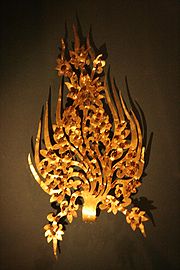 |
an ornament attached to crowns or hatshttp://100.nate.com/dicsearch/pentry.html?s=K&i=244109&v=44 |
| Jumeoni | http://100.nate.com/dicsearch/pentry.html?s=K&i=249365&v=44 | |
| Norigae Norigae Norigae is a typical traditional accessory that is hung from a woman's jeogori goreum or hanbok chima and so on.... |
pendants http://english.visitkorea.or.kr/enu/CU/CU_EN_8_1_2.jsphttp://english.chosun.com/english/contents/magazine/2001/Shopping200108_1.htmlhttp://www.kccc.ro/Korean_Custome.html | |
| Tteoljam | http://100.nate.com/dicsearch/pentry.html?s=K&i=241798&v=44 |

